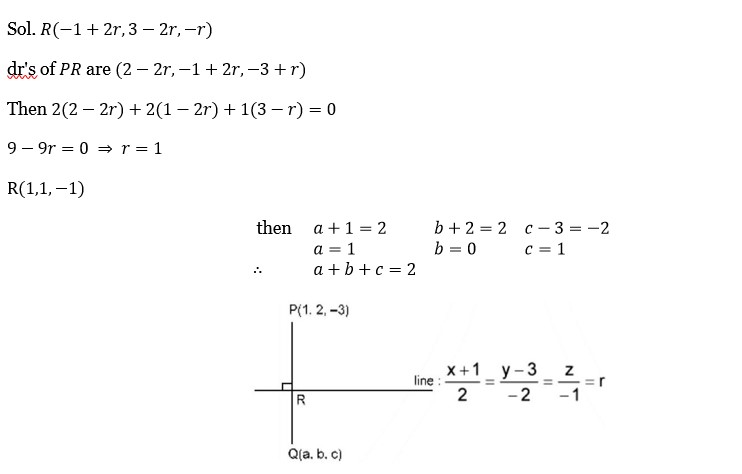Ncert Solutions Maths class 12th
Get insights from 2.5k questions on Ncert Solutions Maths class 12th, answered by students, alumni, and experts. You may also ask and answer any question you like about Ncert Solutions Maths class 12th
Follow Ask QuestionQuestions
Discussions
Active Users
Followers
New answer posted
2 months agoContributor-Level 10
We need to evaluate lim (x→0? ) (cos? ¹ (x - [x]²) ⋅ sin? ¹ (x - [x]²) / (x - x²).
As x → 0? , the greatest integer [x] = 0.
So the expression becomes:
lim (x→0? ) (cos? ¹ (x) ⋅ sin? ¹ (x) / (x (1 - x²)
= lim (x→0? ) cos? ¹ (x) * lim (x→0? ) (sin? ¹ (x) / x) * lim (x→0? ) (1 / (1 - x²)
We know lim (x→0) (sin? ¹ (x) / x) = 1.
lim (x→0? ) cos? ¹ (x) = cos? ¹ (0) = π/2.
lim (x→0? ) (1 / (1 - x²) = 1 / (1 - 0) = 1.
So the limit is (π/2) * 1 * 1 = π/2.
New answer posted
2 months agoContributor-Level 10
Let the equation of the plane passing through (1, 2, 3) be:
a (x - 1) + b (y - 2) + c (z - 3) = 0
The plane contains the y-axis, which has direction ratios (0, 1, 0).
Therefore, the normal to the plane must be perpendicular to the y-axis.
a (0) + b (1) + c (0) = 0 ⇒ b = 0
The equation becomes: a (x - 1) + c (z - 3) = 0
ax + cz = a + 3c
The plane also passes through the origin (0,0,0) since it contains the y-axis.
a (0) + c (0) = a + 3c ⇒ a + 3c = 0 ⇒ a = -3c
Substitute a = -3c into the plane equation:
-3c (x - 1) + c (z - 3) = 0
-3 (x - 1) + (z - 3) = 0
-3x + 3 + z - 3 = 0
-3x + z = 0 ⇒ 3x - z = 0
New answer posted
2 months agoContributor-Level 10
P (at least 2 show 3 or 5) =? C? (2/6)² (4/6)² +? C? (2/6)³ (4/6)¹ +? C? (2/6)?
= (384+128+16)/6? = 11/27
n=27
∴ expectation of number of times = np
= 27 ⋅ (11/27) = 11
New answer posted
2 months agoContributor-Level 10
We have, 1 - (probability of all shots result in failure) > 1/4
? 1 - (9/10)? > 1/4
? 3/4 > (9/10)? ? n? 3 > (9/10)? ? n? 3
New answer posted
2 months agoContributor-Level 9
P (A∪B∪C) = P (A) + P (B) + P (C) – P (A∩B) – P (B∩C) – P (C∩A) + P (A∩B∩C)
Given relations lead to: α = 1.4 – P (A∩B) – β ⇒ α + β = 1.4 - P (A∩B)
Again, from P (A∪B) = P (A) + P (B) – P (A∩B), and given values, it is found that P (A∩B) = 0.2.
From (1) and (2), α = 1.2 – β.
Now given 0.85 ≤ α ≤ 0.95
⇒ 0.85 ≤ 1.2 – β ≤ 0.95
⇒ -0.35 ≤ -β ≤ -0.25
⇒ 0.25 ≤ β ≤ 0.35, so β ∈ [0.25, 0.35]
New answer posted
2 months agoContributor-Level 10
Here D = | 2 -4 λ |
| 1 -6 1 | = (λ-3) (3λ+2)
| λ -10 4 |
D = 0 ⇒ λ = 3, -2/3
Taking an Exam? Selecting a College?
Get authentic answers from experts, students and alumni that you won't find anywhere else
Sign Up on ShikshaOn Shiksha, get access to
- 65k Colleges
- 1.2k Exams
- 679k Reviews
- 1800k Answers


